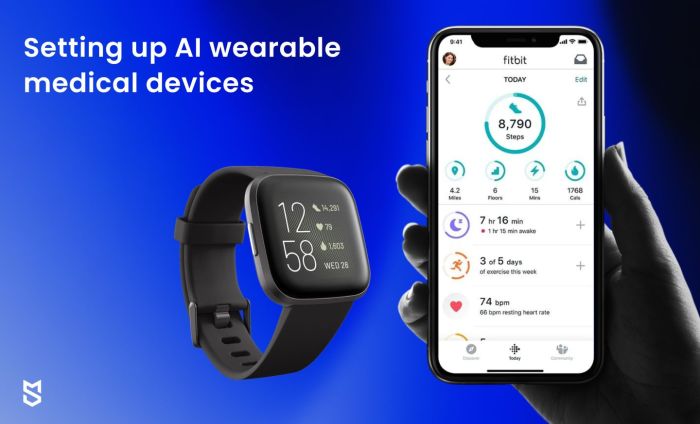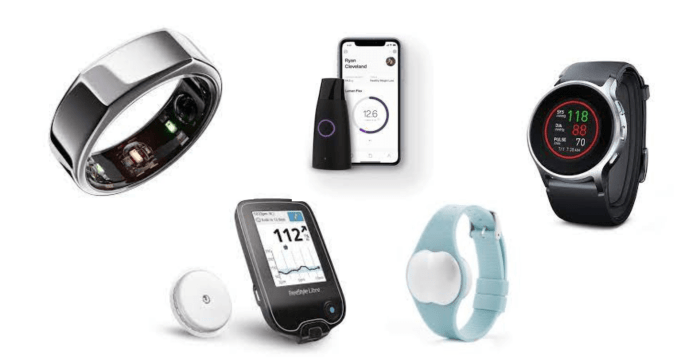Starting with the topic of Best wearable devices for tracking health metrics, this article aims to provide a comprehensive guide to help you understand the world of wearable health technology. From monitoring vital signs to improving fitness levels, these devices play a crucial role in enhancing our overall well-being.
As we delve deeper into the various aspects of wearable health devices, you will discover the key features to consider, the different types of health metrics they track, and the impact they have on our daily lives. Stay tuned to explore the exciting realm of wearable technology and its benefits.
Introduction to Wearable Health Devices

Wearable health devices are electronic devices that are worn on the body to monitor various health metrics, such as heart rate, activity levels, sleep patterns, and more. These devices are designed to provide users with real-time data about their health and fitness, allowing them to make informed decisions about their lifestyle and wellness.
Importance of Tracking Health Metrics
Monitoring health metrics using wearable devices is crucial for individuals looking to improve their overall well-being. By tracking key indicators like heart rate, steps taken, calories burned, and quality of sleep, users can gain valuable insights into their health habits and make necessary adjustments to achieve their fitness goals.
- Wearable devices help users stay accountable for their health goals by providing continuous feedback on their progress.
- Tracking health metrics can help identify potential health issues early on, allowing for timely intervention and prevention.
- By monitoring daily activities and habits, users can optimize their routines to achieve better physical and mental health outcomes.
Popularity and Growth of Wearable Health Technology
The use of wearable health technology has surged in recent years, with more individuals recognizing the benefits of tracking their health metrics on a daily basis. The global market for wearable health devices continues to expand, driven by advancements in technology and increasing consumer awareness about the importance of health monitoring.
“The wearable health technology market is projected to reach $74.03 billion by 2026, with a compound annual growth rate of 15.9% from 2021 to 2026.”
With the rise of smartwatches, fitness trackers, and other wearable devices, the accessibility and convenience of monitoring health metrics have never been easier. This trend is expected to continue as more innovative features and functionalities are integrated into wearable health devices to cater to the evolving needs of users.
Types of Health Metrics Tracked
Wearable devices are capable of tracking a variety of health metrics to provide users with valuable insights into their well-being. Let’s explore some common health metrics monitored by these devices and how they do it.
Heart Rate Monitoring
One of the most common features of wearable devices is the ability to monitor heart rate in real-time. This is usually done through optical sensors that detect blood flow and calculate heart rate based on the pulse. The accuracy can vary depending on the device and placement on the body.
Sleep Patterns Tracking
Wearable devices equipped with accelerometers can track sleep patterns by monitoring movement and restlessness during the night. They can provide information on the duration of sleep, quality of sleep, and even distinguish between different sleep stages. The accuracy of sleep tracking may vary among devices.
Activity Levels Measurement
Tracking activity levels is another key function of wearable devices, allowing users to monitor their daily physical activity and set goals for exercise. Accelerometers and gyroscopes are commonly used to measure steps taken, distance traveled, calories burned, and even specific activities like running or cycling.
The accuracy of activity tracking can be influenced by factors like device calibration and user behavior.
Features to Consider in Wearable Health Devices

When choosing a wearable device for tracking health metrics, there are several key features to keep in mind to ensure you get the most out of your device.
Battery Life
Battery life is a crucial feature to consider in wearable health devices. A longer battery life means less frequent charging, allowing you to track your health metrics continuously without interruptions. Look for devices with a battery life that suits your needs, whether you prefer a device that lasts a few days or one that can go a week or more on a single charge.
Water Resistance
Water resistance is another important feature to look for, especially if you lead an active lifestyle or plan to use the device during workouts. A water-resistant device can withstand sweat, rain, or even a swim, ensuring that your health tracking is not disrupted by water exposure.
Compatibility with Smartphones
Check the compatibility of the wearable device with your smartphone to ensure seamless integration. Most devices come with companion apps that allow you to sync and view your health metrics on your phone. Make sure the device is compatible with your smartphone’s operating system to take full advantage of its features.
Design and Comfort
Consider the design and comfort of the wearable device, as you’ll be wearing it throughout the day. Opt for a device that is lightweight, comfortable to wear, and suits your style preferences. Some devices offer interchangeable bands or customizable faces, allowing you to personalize the look to match your outfit or mood.
Top Wearable Devices for Tracking Health Metrics
Wearable devices have become increasingly popular for tracking various health metrics, providing users with valuable insights into their overall well-being. Here are some of the best wearable devices available in the market today:
Fitbit
Fitbit is a well-known brand in the wearable health device industry, offering a range of devices that track metrics such as heart rate, sleep patterns, and physical activity. Fitbit devices are known for their accuracy and user-friendly interface. The pricing of Fitbit devices varies depending on the model and features, making them accessible to a wide range of consumers.
User reviews often highlight the reliability and effectiveness of Fitbit devices in helping users achieve their health and fitness goals.
Apple Watch
The Apple Watch is another popular choice for tracking health metrics, with features that include heart rate monitoring, ECG capabilities, and activity tracking. Apple Watch users appreciate the seamless integration with other Apple products and services, such as the Health app.
While Apple Watches tend to be on the higher end of the pricing spectrum, many users find the advanced features and design worth the investment. User reviews often praise the sleek design and comprehensive health tracking abilities of the Apple Watch.
Garmin
Garmin is known for its GPS technology and outdoor activity tracking, making it a top choice for fitness enthusiasts. Garmin wearable devices track a wide range of health metrics, such as steps taken, distance traveled, and calories burned. The pricing of Garmin devices varies depending on the model and features, with options available for different budgets.
Users appreciate the durability and accuracy of Garmin devices, especially during intense physical activities. In conclusion, each of these leading brands offers unique features and benefits for tracking health metrics. Whether you prioritize design, accuracy, or specific health tracking capabilities, there is a wearable device out there to suit your needs.
Impact of Wearable Health Devices on Health and Fitness
Wearable health devices have revolutionized the way individuals approach their personal health and fitness goals. These devices offer real-time data and insights into various health metrics, empowering users to make informed decisions about their well-being.
Enhancing Personal Health and Fitness Routines
- Wearable devices provide continuous monitoring of vital signs such as heart rate, sleep patterns, and activity levels, allowing users to track their progress and make adjustments to their routines accordingly.
- They serve as constant reminders to stay active throughout the day, encouraging users to reach their fitness goals and maintain a healthy lifestyle.
- By analyzing data collected by wearable devices, users can identify patterns and trends in their health metrics, enabling them to make positive changes to their habits and behaviors.
Promoting a Healthier Lifestyle
- Wearable health devices motivate users to adopt healthier habits by setting achievable goals and providing feedback on their performance.
- They create a sense of accountability and responsibility towards one’s health, as users become more conscious of their daily activities and their impact on overall well-being.
- Through the use of wearable devices, individuals can proactively manage their health conditions and prevent potential health risks by staying informed and taking preventive measures.
Success Stories and Case Studies
- Many individuals have reported significant improvements in their health and fitness levels after incorporating wearable devices into their daily routines.
- Case studies have shown how wearable health devices have helped users lose weight, improve their cardiovascular health, and enhance their overall quality of life.
- Success stories of individuals achieving their fitness goals and overcoming health challenges with the help of wearable devices serve as inspiration for others to take control of their health.
Conclusive Thoughts
In conclusion, the world of wearable health devices offers a plethora of opportunities to take charge of your health and fitness journey. By leveraging the power of technology, you can monitor your progress, set new goals, and ultimately lead a healthier lifestyle.
Embrace the possibilities that these devices bring and embark on a path towards a fitter, happier you.
FAQ Section
Can wearable devices accurately track sleep patterns?
Yes, many wearable devices use advanced sensors to monitor your sleep patterns, providing insights into the quality and duration of your sleep.
Are wearable devices waterproof?
Not all wearable devices are waterproof, so it’s essential to check the specifications of each device to determine its water resistance level.
Do wearable devices sync with smartphones for data tracking?
Most wearable devices are designed to sync seamlessly with smartphones, allowing users to track and analyze their health metrics conveniently on their mobile devices.

